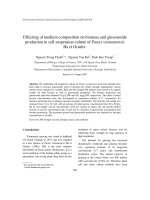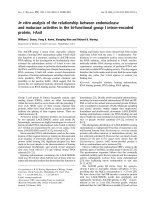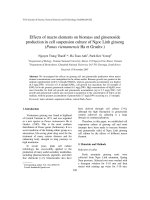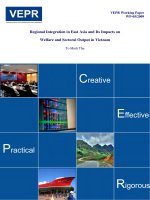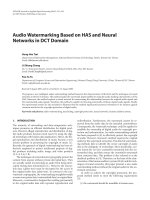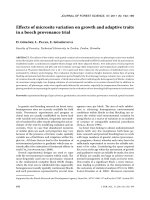Benefit sharing on ecotourism and conservation activities in cat ba national park
Bạn đang xem bản rút gọn của tài liệu. Xem và tải ngay bản đầy đủ của tài liệu tại đây (882.79 KB, 77 trang )
MINISTRY OF AGRICULTURE AND RURAL DEVELOPMENT
VIETNAM NATIONAL UNIVERSITY OF FORESTRY
STUDENT THESIS
BENEFIT-SHARING ON ECOTOURISM AND CONSERVATION ACTIVITIES IN
CAT BA NATIONAL PARK
Major: Natural Resources Management
Faculty: Forest Resources and Environmental Management
Code: D850101
Student: Hoang Dinh Nguyen
Student ID: 1453091211
Class: K59B Natural Resources Management
Course: 2014 – 2018
Advanced Education Program
Developed in collaboration with Colorado State University, USA
Supervisor: Dr. Ngo Duy Bach
Hanoi, June 2018
ABSTRACT
Ecotourism is roughly becoming a hot industry for public and private investors in the
world. Besides, the mutual relationship between ecotourism and conservation is evaluated
importantly in balancing economic and environmental aspect. Thus, stakeholders involve in
ecotourism activities have play crucial role in conservation activities and sustainable tourism.
Cat Ba National Park, due to its impressive natural and cultural tourism resources, has a large
potential to become one of the sought-after ecotourism destinations in the world. In fact, it is
well-known tourist attraction for both inbound and outbound tourist. In this research, by using
useful techniques namely participant observation, semi-structured interviews, questionnaire
survey method, it has given on the general current status of ecotourism development in Cat Ba
National Park (CBNP) in both the center and Viet Hai community-based tourism, and then
identifying some key stakeholders and their role in ecotourism and conservation activities. It
also has contributed to the information in terms of Stakeholder Interactions and its benefitsharing mechanism in two cases. The positive and negative impacts of ecotourism on
conservation has carefully discussed from this research. Ultimately, this research has
produced a set of recommendation on justifiable benefit-sharing in management.
Keywords:
benefit-sharing,
ecotourism
stakeholders, Cat Ba National Parks
i
development,
community-based,
key
ACKNOWLEDGEMENT
Foremost I would like to express my deep gratitude to my principal supervisor Dr.
Ngo Duy Bach for his effective supervision. He is a reviewer, who sacrificed valuable time to
carefully read and feedback my proposal as well as my thesis, despite a short period of time.
In addition, he gives me a help as a bridge connecting me with others important people during
the field trip.
I would like to express my sincere to SJ Vietnam (a volunteer international youth
NGO). They facilitated me as a tourist who came and participated in some volunteer activities
for the local community. They also supported me an accommodation and food for 3 weeks in
CBNB. Joining with voluntary student from Cardiff University, I undergo new experiences
with them when discovery as a voluntourist. It is literally helping to complements my own
topic.
The research also would not be realized without guidance and support from all the
staffs working in The Center for Services, Ecotourism & Environmental Education at Cat Ba
National Park. They gave me a chance to work in their agency as a tour-guide in 2 weeks.
Besides, providing excellent research facilities and a warm welcome, I am extremely grateful
to them for what they have done for me. Particularly, I would like to thank Mr. Cau ,vice
president in travel services and ecotourism, provided me careful guidance throughout the
whole period of 2 weeks in CBNB. I have learnt a lot from him not only academically but
also personality. As a independence, maturity and confidence to work with others offices and
people, which laid solid foundation for this research and further my work in the future.
Special thanks go to the following individuals and organizations: Cat Ba National Park
, Cat Ba Forest ranger station, Viet Hai People‟s Committee, Mr. Hung, Mr. Duc and all the
interviewees who responded to questionnaires and interview in my research. with the
supporting and collaboration from these bodies and individuals, the research has
accomplished more easily.
ii
Finally, it is cannot but mention to my beloved family and friends. My family
supported to me a lot about financial as well as sprits. For instant, they encouraged me in
every single tough moment during the time when I did my thesis. In addition, my friend who
assistance throughout a half of field trip, have tremendous meaning on me when spending
their time to help me in data collection time. There is an inspiration to encourage me to do
more harder.
iii
CONTENTS
ABSTRACT ................................................................................................................................ i
ACKNOWLEDGEMENT .......................................................................................................... ii
CONTENTS .............................................................................................................................. iv
ABBREVIATIONS ................................................................................................................... vi
TABLE CONTENTS ............................................................... Error! Bookmark not defined.
FIGURE CONTENTS .............................................................. Error! Bookmark not defined.
Chapter I: INTRODUCTION ..................................................................................................... 1
1.1 Rationale ............................................................................................................................... 1
1.2.1 General objective: .............................................................................................................. 2
1.2.2 Detailed objectives: ........................................................................................................... 2
1.3 study area .............................................................................................................................. 3
1.4 The structure of the thesis..................................................................................................... 5
Chapter II: LITURATURE REVIEW ........................................................................................ 6
2.1 introduction........................................................................................................................... 6
2.2 Defining Ecotourism ............................................................................................................ 6
2.3 The participation of stakeholders in ecotourism activity...................................................... 7
2.4 Relationship between ecotourism and environmental conservation..................................... 9
2.5 Ecotourism and voluntourism............................................................................................. 10
Chapter III: RESEARCH METHODOLOGY ......................................................................... 12
3.1 Case study approach ........................................................................................................... 12
3.3 Data collection .................................................................................................................... 13
3.3.1 Questionnaire Surveys ..................................................................................................... 13
3.3.3 Semi-structured interviews .............................................................................................. 13
3.3.4 Participant Observation ................................................................................................... 14
3.3.1 Document analysis or secondary data analysis ............................................................... 15
iv
3.3 Data analysis ....................................................................................................................... 16
4.1 Current status of ecotourism and conservation activity in CBNP. ..................................... 17
4.1.1 Infrastructure and tourism services.................................................................................. 17
4.1.2 Tourist frequency in CBNP ............................................................................................. 20
4.2 key stakeholders in ecotourism activities ........................................................................... 23
4.2.1 Non-local actors ............................................................................................................... 23
4.2.2 Local actors...................................................................................................................... 26
4.3 Interaction among stakeholders ......................................................................................... 31
4.3.1 Park headquarters ........................................................................................................... 31
4.3.2 local communities participant .......................................................................................... 36
4.4 Impacts of Ecotourism on Conservation activities. ............................................................ 38
4.4.1 Positive impact ................................................................................................................ 38
4.4.2 Negative impact ............................................................................................................... 43
Chapter V: Discussion .............................................................................................................. 45
5.1 The role of stakeholders ..................................................................................................... 45
5.1.1 Donor organizations ........................................................................................................ 45
5.1.2 Public Sector ................................................................................................................... 45
5.1.3 Private Sectors ................................................................................................................ 46
5.1.4 Local Communities ........................................................................................................ 46
5.1.5 Tourists ............................................................................................................................ 46
5.2 Benefits Distribution Mechanism ....................................................................................... 47
5.4 Proposing solutions for sustainable ecotourism development in association with forest
resource management. .............................................................................................................. 49
Chapter VI: Conclusion ............................................................................................................ 51
REFFERENCES
APPENDIX
v
ABBREVIATIONS
CBNP
Cat Ba National Park
PAs
Protected area
DMOs
destination marketing organizations
CBE
Community-based ecotourism
CEEE
Center service of ecotourism and environmental education
TDP
Tourism Development Department
PA
Removing barriers hindering protected area management
effectiveness in Vietnam (Project)
vi
List of Tables
Table 1.1: Species in Cat Ba Biosphere Reserve............................................................................ 4
Table 4.1. Group of development projects associated with conservation in recent years ............. 24
vii
List of Figures
Figure 1.1: The map of Cat Ba Biosphere Reserve. ........................................................................ 3
Figure 4.1 Temporal recuse in Park headquarters ......................................................................... 18
Figure 4.2 Information board in Park headquarters ....................................................................... 18
Figure 4.3: Number of domestic and international visitor in terrestrial tourist routes and
marine tourist routes in period of 5 year from 2013 to 2017 ......................................................... 20
Firgure 4.4 Mangrove ecosystem in Phu Long.............................................................................. 23
Figure 4.5 Local clay house in Viet Hai ........................................................................................ 23
Figure 4.5 : CEEE‟s staffs assess their salary (n=13) .................................................................. 31
Figure 4.6: Travelers assess current tickets price (n=20) .............................................................. 32
Figure 4.7: Travelers assess current commodity (n=20) ............................................................... 33
Figure 4.12: locals responsibilities in ecotourism (n=14) ............................................................. 36
Figure 4.13: comparing monthly Family Income between locals participant and locals nonparticipant ecotourism. .................................................................................................................. 37
Figure 4.15: Some of volunteer activities in CBNP ...................................................................... 42
Firgure 4.16: Trash left by visitors on the "Kim Giao forest - Ngu Lam Peak"............................ 44
viii
Chapter I: INTRODUCTION
1.1 Rationale
National Parks and natural landscape are increasingly interested in the use of land for
tourism development. It is considered to be an important foundation for the development of
the Ecotourism and to bring about the benefits of economic and social development.
However, whether or not the development of ecotourism in the national parks ensure the
requirements for resource protection depend much on local community.
In Vietnam, as soon as the national parks are established, communities living in the
core and buffer zone depend on the resources of the nature reserve. They face a lot of
difficulties in changing their previous lifestyles such as limited harvesting forest products or
shrinking field areas. in order to compensate for those disadvantages, many policies and
projects are being developed to support and enhance the quality of life of people as
"Programme 135" to support finance for people living in remote areas. The tourism
development project is being implemented in most of the national parks in Vietnam.
However, the effects of the tourism promotion are not much supporting the economic growth
of local community and the conservation activities. Participation of local people living in
buffer zone is interested by authorities in ecotourism activities in Vietnam National Parks. In
fact, however, the participation of the community in tourism activities was very limited and
totally unorganized. The benefits-sharing issues among national parks, travel agencies, and
local communities are much limited when almost profits come to individuals or small group
which have a certain knowledge and capital.
It is undeniable that the benefits-sharing on ecotourism and conservation in National
park with stakeholders is Inappropriate. Local communities are almost out of the running or
traveling spontaneously. Even authority in national park who directly manage tourism
resources are also out of tourism activities passively and dependently. Cat Ba national park is
typical appropriate case study for several reasons. Firstly, the development of tourism as well
1
as conservation activities are dramatically increasing in recent years. Secondly, CBNB is also
well-know a highly biodiversity values area with special species and ecosystems that are in
danger of extinction. Thirdly, the poverty and ecological problems still remain, while
increasing Island‟s population both local resident and tourists requires an increasing food,
services supplies and especially acreage of land-use that are affected a lot on conservation
activities.
In order to examine the benefits, current status, and shortcomings of benefit-sharing in
CBNB. based on this, I recommend solutions for community-based tourism and implement
conservation and development objectives in developing ecotourism particularly and CBNB
resources generally. That‟s why The topic “THE BENEFIT-SHARING ON ECOTOURISM
AND CONSERVATION ACTIVITIES IN CAT BA NATIONAL PARK” was carried out in this
thesis.
1.2 Objective
1.2.1 General objective:
To develop sustainable ecotourism in association with sustainable forest resource
management and protection in Cat Ba National Park
1.2.2 Detailed objectives:
-To assess the current status of ecotourism and conservation activities in Cat
Ba National Park
-To identify stakeholders in ecotourism activities in Cat Ba National Park
-To study on benefit-sharing mechanism of ecotourism in Cat Ba National Park
-To study on the impacts of ecotourism on conservation activities in Cat Ba
National Park
-Proposing solutions for sustainable ecotourism development in association
with forest resource management
2
1.3 study area
Cat Ba Biosphere Reserve, with an area of 285 square kilometers, would have been
the largest of 366 islands in Ha Long Bay UNESCO Heritage site in northern Vietnam. The
majority of the land is cat Ba national park, also known as a first national park in Vietnam
cover both terrestrial and marine ecosystems with high diversity, namely Tropical humid
forest; Wetlands; Mangroves and Coral reefs.
Figure 1.1: The map of Cat Ba Biosphere Reserve.
(source: Cat Ba national park management board)
Owing to its beauty landscape and worldwide importance to biodiversity conservation t
archipelago attracts numerous NGO‟s and international scientist interests in special
ecological, especially the high number of endemic species. The golden-headed langur
(Trachypithecus poliocephalus) is one typical example, the world critical endangered species
that is listed as one of rarest global primates because of its restricted range and small
population size (UNESCO,2007) and only exists in Cat Ba island . Besides the Langur, there
3
are numerous valuable and rare plant and animal species, have been recorded in Cat Ba, about
80 of total 2,320 existing species (table 1) have been identified endangered and classified in
the Vietnam's Red List (Vietnam National Commission for UNESCO 2011).
Table 1.1: Species in Cat Ba Biosphere Reserve
Number of
Number of species in
species
Vietnam's Red data book
- Terrestrial plants:
741 species
27
- Forest wildlife:
282 species
30
- Wetlands plants
23 species
- Sea weeds:
75 species
- Phytoplankton:
199 species
- Zooplankton:
89 species
- Marine bottom species:
538 species
- Marine fishes:
196 species
- Corals:
177 species
Categories
8
8
(source: Vietnam National Commission for UNESCO 2011)
Cat Ba National Park (CBNP) was established in 1986 in the Cat Ba archipelago, Cat
Hai district. It is situated 50 km east of Hai Phong, 25 km south of Ha Long city, 100 km
south-east of the Capital Hanoi, and It borders Ha Long Bay in the north of Cat Ba National
Park with geographic coordinates: : 20°44′50″ to 20°55′29″ N, 106°54′20″ to 107°10′05″ E.
Cat Ba National Park is located on the border of six communes, namely Gia Luan, Phu Long,
Hien Hao, Xuan Dam, Tran Chau, Viet Hai and Cat Ba town. , which are located in the buffer
and transitional zones of Cat Ba Archipelago‟s Biosphere Reserve.
Economic development in Vietnam has been more equal than in many other countries
in the same kind of situation, but the economic growth has not always lead to poverty
reduction. Statistics on tourism in Cat Ba work as a good example. The number of visitors has
4
increased rapidly between the years 1995 and 2007, from 45,000 visitors to 729,000 visitors.
The number of visitors increased in twelve years by more than 16 times. However, poverty
has not decreased much during this time. From 2000 to 2008 the number of people living in
poverty has decreased a little bit more than one percent, from a little more than nine percent to
slightly less than eight percent. At the same time, the gross national income (GNI) per capita
based on purchasing power parity has almost doubled.
Over 100 hotels were built in Cat Ba between the years 1995 and 2009 (Tuyen et al.
2010, 6) and more are being constructed all the time. There is a massive resort project in
progress called Cat Ba Amanita, in which around 800 luxury villas and other tourism
complexes, such as amusement park, sports areas and an international congress Centre, are
being built in a 172-hectare area (Knight Frank 2013; Vinaconex – ITC 2013).
1.4 The structure of the thesis
This thesis is arranged in five chapters. Each chapter is presented as follows:
Chapter I: to provide a background information of thesis.
Chapter II: to examines literature review related to research.
Chapter III: to devote research design.
Chapter IV: to show the finding and result are discussed from two case study.
Chapter V: to give an discussion and recommendation around the finding and results.
Chapter VI: to provide a conclusion from this research.
5
Chapter II: LITURATURE REVIEW
2.1 Introduction
While the ecotourism concept was defined a long time ago, the meaning of this concept was
somehow misunderstanding definition in some context. Especially, in Vietnam, this concept
just was focused on in recent years.
This chapter aim to clarify the meaning of ecotourism and others related-terms, and also
reviewing at general art and ecotourism development in Vietnam as also Cat Ba national park,
where is often involved a lot of tourist and attractive stakeholders. As a huge of number
ecotourism spot are located in CBNP, and the relationship among parks, tourists and locals
are examined. Some closely relationship between ecotourism and conservation as well as
ecotourism impacts, locals participant, benefits sharing among stakeholders also are
discussed.
2.2 Defining Ecotourism
In fact, having a lot of definitions of ecotourism, but one of newest and clearest is now define
that "ecotourism is responsible travel to natural areas that conserves the environment, sustains
the well-being of the local people, and involves interpretation and education" (TIES, 2015).
Education is meant to be inclusive of all staffs and tourists and locals. On the other hand,
there is a lot of discussion about defining ecotourism „as it is a vibrant movement that has so
many definitions that can be defined by its lack of definition‟ (Singh, 2008, p.113). This
opinion is reasonable focusing that study as much as 85 defining ecotourism. Despite this rich
variety of definitions, in general, Fennell (2001) posit that the most common aspect in
ecotourism definitions refer to (1) where ecotourism occurs, (2) conservation, (3) culture, (4)
benefits to locals, and (5) education.
The immense definition of ecotourism as a nature-based, culturally sensitive form of tourism
was taken up enthusiastically because there appeared to be few losers. The Governments were
given a convenient escape route as eco-tourism appeased the naturalist and indigenous
6
communities, but still provided revenue. Naturalist posit that ecotourism is an alternative to
mass tourism and its resource-exploiting ways. Local communities envisaged receiving at
least a percentage of the tourist dollars, creating job opportunities and giving them control
over the impact on their own communities. It seemed that the benefits of mass tourism were
going to be expanded in the new world of eco-tourism to include cultural, social and
environmental elements.
2.3 The participation of stakeholders in ecotourism activity
To be better understand in terms of ecotourism, a short illustration of stakeholder is involved.
As each ecotourism stakeholder potentially has its own special dimension for the PA and
various benefits and incentives for ecotourism.
Table 2.1: Potential ecotourism stakeholders in a protected area
PA management agency
Environmental and cultural groups and associations
Local community
Sports clubs
PA visitors
Economic development organizations
PA volunteers
Research bodies
PA employees
Educational institutes
Landowners (in and around the area)
Concessionaires, licensees and permit holders
Residents (in and around the area)
Hospitality industry
External investors
Tour operators
Local authorities
Destination marketing
Government ministries
organizations
Other governmental agencies
Educational institutions
7
Local cooperation & partnerships
Research bodies
Profit-making private sector
Independent experts
Non-governmental organizations
Media
Sources: Eagles (2002) and Alexandrov (2014)
It is undeniably to posit that the collaboration among different stakeholders,
ecotourism is crucial for planning of development activities in respective destination spot.
PAs managers, locals and travelers are by definition key stakeholders. The extent to which
secondary stakeholders are figured and involved in a PA, depending on its powerful and how
much respected they are in their zones. For instance, in some PAs, Non-Governmental
Organizations (NGOs) are firmly involved in the ecotourism management, planning. Leading
to they should be a considered as a key stakeholder.
In increasing of tourism in protected areas, PA management agency must promptly
pay attention to the kind and condition of tourist experience offered, and simultaneously must
protect the ecological integrity of the park (Priskin and McCoo, 2006). In some cases, PA
management agencies are enforcement by the law responsible for the ecotourism in the area.
8
In other case, destination-marketing organizations (DMOs) are commonly charged
with the mission of increasing the quantity of tourists that have positive influence on the local
economy. On the other hand, the PAM enforce the mission of protecting wildlife populations,
ecosystems and natural resources. Park managers are concerned about arranging and
educating visitors in order to minimize environmental effects (Manfredo,2008). there are four
key strategic objectives should be tackled by DMOs (Buhalis, 2000):
(1) enhance the long term prosperity of local people.
(2) delight visitors by maximizing their satisfaction.
(3) maximize profitability of local enterprises and maximize multiplier effects.
(4) optimize tourism impacts by ensuring a sustainable balance between economic benefits
and socio-cultural and environmental costs.
2.4 Relationship between ecotourism and environmental conservation
Conservation issues are now at the forefront of public concerns. The increase of
deforestation, losses of diverse species, climate change and expanding land degradation have
compelled public support for conservation. Conservation basically relates to the human
management resources in a struggle to restore, enhance, protect, and maintain the quality and
quantity of diverse species, ecosystem conditions, and future generations (Dunster,1996).
Therefore, ecotourism has been illustrated as a key solution due to its potential for helping
conservation of natural environment and boosting sustainable development (Boo 1990;
Buckley 1994; Wallace and Pierce 1996; Lindberg et al. 1997). Natural resource conservation
is vital because ecotourism is a form of nature-based tourism as depending on the natural
environment for its existence. Tourism is a valuable solution to natural resource conservation
due to part of the revenue from tourism can be re-invested into sustaining protected areas
(Budowski 1977)
The development of ecotourism as a sustainable of environment and economic via
conservation strategy. Researchers have concerned about the opportunity of tourism operators
9
are capitalizing on an ecotourism‟s attractive to promote activities with small or not correct
attention to environmental and social tension (Wright 1994). there are a lot of examples of
ecotourism that have effective conservation goal by raising awareness and creating jobs for
stakeholders, whereas other cases demonstrate that it can also harm environmental goals
through unintended side effects or the adoption of the term „ecotourism‟ by group of people
realizing capitalize on it (Stem et al. 2003) A typical example of this is ecotourism
development in Costa Rica, where ecotourism turns into more concentrated on getting high
revenue. The purpose was identified as an economic aspect than its initial purpose, which was
maintained pristine forest from agricultural (Honey 1999).
Ecotourism will not save loss ecosystems or liberate poverty communities. Indeed,
unless it is planned to diminish harmed environment, maximize economic revenue and
involve regional communities, then it might truly harm the environment Protected areas and
livelihood of locals. But if ecotourism is used as a tool for sustainable development, taking
benefit from revenue transfer to conservation activity objectives by Eco tourists as activist
(Whelan 1991).
2.5 Ecotourism and voluntourism
Voluntourism or “humanitarian tourism” is the new term in following recent years. It
is quite hard to search exactly the meaning of this term. According to Tomazos (2010)
“Voluntourism is a form of travel which involves volunteering for a worthy, often charitable
cause“. these work can be listed as teaching small children in mountainous or remote areas,
building charity house, joining conservation or environmental activities. They can gain benefit
from their real experience and knowledge from these activities. On the other hand,
voluntourism was defined by some Non-governmental organizations as a bad phenomenon.
Some enterprises or groups use business methods of the mass tourism industry whereas taking
the definition of international volunteering as a facade and making profits from the goodwill
10
of young international volunteers. Voyeurism is the only thing those voluntourism companies
sell! (Sj Vietnam,2016)
Therefore, Ecotourism have close relationship with voluntourism when almost
volunteers execute in same areas and close purpose with Ecotourist. In other word,
international and domestic volunteers are one of stakeholder sharing benefits with others in
ecotourism, while they are one part implement raising awareness in protect environment for
locals as well as themselves and others visitor.
11
Chapter III: RESEARCH METHODOLOGY
To understand how the ecotourism affects its resources and provide information for the
collective management to evaluate its resource management practices. The process of
collecting information is as important as the data itself, as it triggers dialogues with the
community, foresters, NGOs, and local government to examine existing resource use
practices, problems, conflicts, and opportunities, providing a basis for developing more
sustainable and productive management systems. There are several processes to collect data
which shown in the following part:
Figure 3.1: Flow chart of research processing.
3.1 Case study approach
In this research, two main case study were selected for comparative purpose. The area
of center of national park and Viet Hai village are 2 developed areas on ecotourism in CBNP.
The first area has managed by the management of government with all staffs play a crucial
role in maintaining diversity of ecological system of forest in Cat Ba.
On the other hand, Viet Hai commune and two hamlets of the Tran Chau commune
are located directly within the CBNP‟s core zones. While the main Viet Hai‟s livelihood is
changing considerably from forest-based into ecotourism activities. the stakeholder's
management in Viet Hai community has broadened responsible and roles, resulting in they
12
have made a plans about how to develop their livelihood as community-based tourism activity
in CBNP.
3.3 Data collection
3.3.1 Questionnaire Surveys
Questionnaire surveys were conducted in Park center and Viet Hai village areas to
gain deeper insights and to triangulate the obtained results. The set of questionnaires (see
appendix) was designed based on the results from qualitative interviews. The questionnaire
has 3 types corresponding with 3 targets namely staffs working in CBNP, tourists and local
residents.
A total a number of 12 questionnaires were conducted with staffs working in Center
service of ecotourism and environmental education (CEEE). To more precise, both
government staffs and staffs of joint stock company were distributed questionnaire. Besides, 4
trainees who are student spending time for their fieldtrip also gave information to my thesis.
For the tourist, there are 20 questionnaires were handled in a random selection. In
addition, I have a chance to became a tour guide. This helped me to effectively facilitate the
data collection process, when I have regular contacts and friendly relations with tourists who
visited CBNP
In Viet Hai village, 20 residents, who have been involved and not involved in tourism
activities, were filled in questionnaire. The surveys were completed in 2 days with the
supporting from my friend.
3.3.3 Semi-structured interviews
The individual in-depth interview is a way in which the interviewer does not strictly
adhere to a formalized set of questions, they will spend time to asking an open-ended
questions, when giving the participants a discussion rather than formalized question (Alison
Doyle, 2018) . Semi-structured interview allow researchers modifying the order or adjusting
the content of the topics in flexible way. At times when the information given by the
13
interviewees was not clear enough, so these main questions were followed up by a request
examples, or by supplementary questions. The purpose of this extra questioning was to
acquire a clearer and richer picture of the participants‟ perceptions and understanding of
researchable issues.
In this research, total 7 semi-structured interviews were conducted with key
informants such as president of CEEE, vice-president of CEEE, head of forest agent, village
chiefs, elders and joint stock company‟s managers. I had prepared only a list of general topics
to be addressed, and then it was reasonably customized with interviewees‟ tasks
responsibilities in ecotourism. The meeting lasted between 20 minutes and a half hour.
3.3.4 Participant Observation
According to Yolanda Williams (1998) Participant observation is define as “a
qualitative research method in which the researcher not only observes the research
participants, but also actively engages in the activities of the research participants”. In
addition, According to Spradley (1980, p. 34), participant observation occurs in three phrase
including descriptive observation, focus observation and selective observation. Descriptive
observation indicated that an observer tries to sense an overall picture of the study site, which
supports the researcher to understand complexity of the field and take more specific research
questions. Focus observation copes with focusing attention on specific problems aimed to
execute investigation, while selective observation concerns with finding extra data to
demonstrate the second phrase. Thus, participant observation method were carried out during
3 time phrase in my thesis.
In the first fieldwork phase, I tried to understand a general picture about the
ecotourism activity organization and the overview characteristics of the travel agency, local
communities through descriptive observation. I took part in tourism-related activities as a
tourist and tour guide and had a 4 week stay in CBNP. I attended all of terrestrial and marine
routes namely kayaking in Lan Ha bay and trekking tour through primitive forest . I
14
participated in trekking tours to the protected area and stayed overnight with homestay
families in the Viet Hai villages. While taking part in the activities, I had informal discussions
with and community leaders to gain extra insights and to create rapport between our group
and prospect interviewees. It facilitated the contribution of the next fieldworks.
In the second fieldwork phase, I tried to narrow down in the focus observation, by
concentrating on the related issues. For example, how local residents participated in
purchasing and guiding visitors. I spent a dozen times in real trip in travelling in order to
interview visitors and local communities in parallel with the observation.
Selective observation was implemented during the final fieldwork phase. Some critical
issues (e.g. illegal logging, land conflict), which gathered from the first and second
fieldworks, were raised in the meeting with in-depth stakeholders.
3.3.1 Secondary data analysis
Secondary data analysis can be literally defined as “second-hand” analysis. It is the
analysis of data or information that was either gathered by someone else (e.g., researchers,
institutions, other NGOs, etc.) or for some other purpose than the one currently being
considered, or often a combination of the two. If secondary research and data analysis is
undertaken with care and diligence, it can provide a cost-effective way of gaining a broad
understanding of research questions.
In this research, depending to specification of each study sites, information and data
reviewed involves collecting information, statistics, and other relevant data were gathered in
multiple reliable source such as CBNP offices, Viet Hai Commune People's Committee, etc.
In general, the types of information have conducted following as:
Demographic (population, population growth rate, gender, ethnic groups, migration
trends, etc.)
Gender equality (age, ethnicity, etc)
Policy environment
15
Economic environment (growth, debt ratio, terms of trade)
Poverty levels (poverty and absolute)
Employment and wages (formal and informal; access variables)
Livelihood systems (on-farm, off-farm, informal, etc)
Agricultural variables and practices (rainfall, crops, soil types, and uses, irrigation, etc.)
Health services (#/level, services by level, facility-to-population ratio; access by gender,
ethnicity. etc.)
Education (adult literacy rate, school enrollment, drop-out rates, male-to-female ratio,
ethnic ratio, etc)
Schools (level, school-to-population ratio, gender, etc.)
Infrastructure (roads, electricity, communication, water, sanitation, etc.)
3.3 Data analysis
Data analysis was carried out after and during writing time. By applying statistical
methods as description and comparative method, it is helped to know how many collected
data was conducted and categorized them. In most case, the conducted data were messed in
textbook because the processing conduct very fast, then the researcher took note unorderly.
two types of analysis were possible: excel software and by hand. The data was analyzed by
Calculates number of responded into percentages and then it was illustrated by many type of
chart. On
the other hand, questionnaires were provided in Vietnamese for Locals and
domestic visitors, they are needed to translate carefully into English for the exact meaning of
research questions. Furthermore, direct quotations from interviewees were chosen as an
examples of broadly expressed in this writing. All words from the quotations needed to keep
exactly form from Vietnamese and then translate into English with quotation marks.
16

